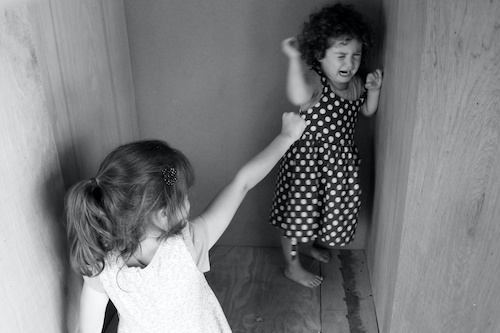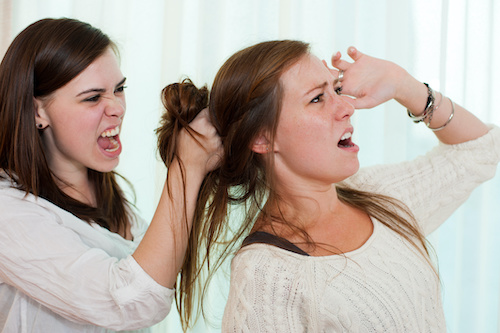Sibling abuse isn’t sibling rivalry or jealousy.
Sibling abuse is emotional, physical or sexual abuse by a sibling.
Often parents don’t see it for what it is – abuse. As a rule, parents and society expect fights and aggression between siblings. This contributes significantly to families’ blindness to it and sets the stage for it to go on. Because of this, parents don’t see sibling abuse as the serious problem it is, unless confronted by the serious harm that occurs.
Even when evidence of serious harm is clear, family tends to normalise, minimise and rationalise what happens in sibling abuse, leaving the target isolated and exposed to ongoing abuse without effective protection. Typically, parents interpret what is going on as jealousy and rivalry. The target of the abuse may be seen as ‘complaining’, whingeing, or trying to manipulate parents into ‘siding’ with them. In doing so, parents often completely miss the very real cry for help. Without the aid of adult support and adult power to intervene and break the campaign of abuse, the victim is left defenceless in the face of the violence.
By the time people present in my practice, with all the downplaying, discounting, and rebranding of what’s happened to them by abusers and other family members, targets of sibling abuse often doubt themselves and the seriousness of their experience. It’s only when I ask searching, detailed questions, and start to point out the imbalance of power, the systematic campaign of targeted torment and cruelty enabled by a context of adult denial about the facts, that people start to give themselves permission to call their experience what it was.
Some studies estimate that around 3% of children are dangerously violent towards a sibling. A 2005 study in the US estimated assaults by a sibling to stand at around 35% a year. That finding held across all socioeconomic classes. Due to the ongoing denial about the seriousness of sibling abuse, it’s hard to accurately assess its prevalence.

Identifying sibling abuse
The American Association for Marriage and Family Therapy (AAMFT) says – “Sibling violence or abuse can be described as a repeated pattern of physical aggression with the intent to inflict harm and motivated by a need for power and control. It is targeted”[I].
Often, it is an escalating pattern of aggression that parents have difficulty stopping. Some of the most important questions to ask are: “Is one child consistently a victim of the other?” “How often and how long has the behaviour been occurring?” In my experience, if parents and teachers do become aware that something is going on, they frequently treat what they see as a one-off occurrence, instead of digging deeper and asking the kind of questions that would reveal the full extent of the target’s experience. This serves to further silence and disempower the target of the abuse.
When one child is always the loser, the aggression keeps escalating, and if parents do not intervene effectively, the safety of the victimised child should become the primary concern. To accurately assess the child’s safety, adults need to be willing to ask difficult searching questions, and furthermore, to hear and be prepared to believe hard-to-hear answers. Adults need to be willing to put facing reality about the nature of their children’s relationships ahead of their investment in playing happy families. In order to do this, adults need to question their assumption that anything that happens between siblings is benign – because research shows this is NOT the case.
In addition to more overt physical violence, as occurs with domestic violence, I have found there is always an emotional verbal component to sibling violence as well. Frequently, the aggression begins as so-called “teasing”. This is more accurately described as “taunting”. It might include ridiculing, insulting, threatening, terrorizing, humiliating and belittling a younger or less powerful sibling[ii].
We don’t want to call it what it is …
In the 1940s, child psychiatrist Levy first coined the term “sibling rivalry” to describe an older sibling’s jealousy of a new baby, carrying connotations of natural, instinctive behaviour[iii].
While sibling rivalry is a normal and mostly healthy part of growing up, sibling abuse isn’t rivalry. Nor is it about jealousy. Rivalry and jealousy may play a part, but they do not explain the escalation to violence, and the sustained campaign of systematic targeted abuse that is meted out by perpetrators of sibling abuse.
It isn’t only parents, families, and educators who don’t seem to want to see abuse for what it is. The language in the psychological literature slides quickly into the more palatable term “bullying”, rather than calling the behaviour what it is — abuse[iv] . I believe this reflects our society’s discomfort with calling out abuse when it comes to targeted abuse of a child in a family context. As a former first responder in child sexual assault in the 1980s and 1990s, for me, this echoes the well-documented wholesale denial our society previously displayed about childhood sexual assault, particularly within the family[v].
In an attempt to try to recognise degrees of victimisation and acknowledge a greater level of seriousness[vi] , authors use the word severe to try to distinguish ‘ordinary’ bullying from sibling abuse, while still not using the word abuse. Severe bullying in the literature is referred to as — severe, repeated and deliberate efforts to harm someone in the context of a power differential which makes it difficult if not impossible for the target/victim to protect or defend themselves[vii].
Surely that’s what abuse is? What is it with our reluctance to call a spade a spade?
One author made a point of saying we don’t want to call “everything” bullying (sic). I find this focus on and investment in trying to make sure that ‘not everything’ gets called abuse fascinating. Whose interests are being served? Having chosen the promising title “Sibling abuse and bullying”, Kennedy-Moore (2015) proceeds to only use the term bullying throughout the rest of her paper[viii].
Similar to childhood sexual abuse, the core ingredients of a significant power differential and isolation are central to what enables the abuse to go on and escalate, often/usually undetected by the adults around the sibling pair.
In this article, when I cite researchers and specialists in the area of childhood abuse who refuse to use the term abuse and refer to ‘bullying’ instead, I will add the words I consider more appropriate, i.e. abuse, abuser, in brackets. I believe that, in doing so, the lengths to which the field of psychology and education go to in order to play down the issue of sibling abuse are laid bare.
“What [abusers] commonly share are low levels of empathy and a highly developed theory of mind (the ability to understand the state of another person’s mind and emotions). [Abusers] are skilled at manipulating the fears and insecurities of their victim and calculating who should or should not witness[ix]*.
Prof Dan Olweus, the Swedish pioneer of bullying research says that [abusers] generally (if not always) realise that their behaviour causes distress and pain. Victims speak of their sibling’s tangible pleasure inflicting pain[x].

Effects
Mental health
There is a well-established association between being abused by a sibling and mental health difficulties. A UK study in 2014 (with over 6,000 children) in which Wolke collaborated, found that being [abused] by a sibling at age 12 doubled the odds of depression, anxiety and self-harm by age 18.
What is less documented are the long-term effects, including residual mental distress and psychological problems. Family relationships can be fractured – particularly when parents (and others) continue to view the problem as a relational issue between two people, dismissing it as a ‘personality clash’, even blaming the victim for not defending themselves or alienating themselves[xi].
It’s hard for victims to be taken seriously when their experience is described in such dismissive and minimising terms. It’s hard for victims to take their own experience seriously when this is the case.
Nowhere to go: parents don’t act, and even normalise it
Normalisation of sibling abuse is arguably its greatest fuel and inevitably results in a lack of social support for victims. An American study published in 2016 in the Journal of Family Violence found that responses most frequently encountered when victims reported sibling violence or sibling sexual abuse to a parent or adult were that it is:
- normal
- not serious
- the victim’s fault
- a private matter or
- taboo[xii].
This echoes the way women’s reporting of sexual assault is met in societies everywhere to this day.
As Bronagh put it, nobody wants to hear about “weird family stuff”.
Parents appear to be reluctant to identify the behaviour as abusive, even blaming the victim for provoking the abuser. They commonly tell victims on reaching 18, that the problem is now out of their hands. Having had the seriousness of what was going on denied and minimised when they were younger, once they reach adulthood, victims of sibling abuse are left completely on their own. If they show any signs of ongoing distress or animosity around their abuser, other family members may see this as a sign of immaturity, divisiveness, manipulativeness, and bearing a grudge. Once again, the victim of sibling abuse is blamed, marginalised and left with no support.
Indeed, similarly to incest survivors, if they insist on having their experience heard, the victim is seen as ‘making trouble’ among family relationships.
For the victim of sibling abuse, however, because they live with its long term consequences, there’s no escape.
Take charge of the story
Brene Brown says that, “When we deny our stories, they define us”.
Victims of sibling abuse need to be brave enough to call their experience, at least in their own mind, what it was: abuse. Otherwise, the dominant family narrative about what happened and the rebranding of their experience will continue to dominate and hurt them.
Part of maturity is having the courage to call our experience what it was, to refuse to be defined by others. Unfortunately, it also may require being willing to risk losing family ties if loyalty lines are drawn once the target of abuse stands by their description of their experience at the hands of their abuser. Family members can be very resentful and blame the target of abuse if they feel forced to ‘choose sides’. It is not uncommon for the target to pay the price of loss of connection if this happens, particularly if the abuser is seen as having good standing in the family.
In reclaiming their story and refusing to go along with the dominant family narrative to ‘keep the peace’, survivors of sibling abuse get to stand in their dignity and truth.
If you have been the target of sibling abuse, consider the following:
- Write down in behavioural terms what happened as descriptively as you can – how old you were, how old your abuser was, who did what to whom, actions, words, who was around, when these events happened?
- Did your violent sibling tell you what they felt towards you, why they felt justified for treating you the way they did?
- If you tried to make sense of your experience at the tie, what did you come to think or believe about yourself as a result of your sibling treating you this way?
- If you tried to stop your abuser for hurting you, how did you try to stop them? What did they do? What impact did this response have on you?
- If you tried to tell anyone, what response did you get? Did the adults give you a sense that they genuinely wanted to hear your story, that they believed you, that they took you seriously? What impact did this response have on you? Were they effective in bringing the abuse to a stop? If yes, what did they do to make it stop? If no, what happened that enabled the abuser to go on abusing you?
- If you tried to tell and you were not believed or you were punished, what happened? What reasons did the adults give you for taking their position? What impact did this response have on you?
- If you didn’t try to tell anyone, what got in the way? What were the factors that made you decide to continue try to deal with this situation on your own?
- Today, what do you think are the ongoing effects of what you experienced at the hands of your violent sibling? How did these effects get in the way of you living the life you want to live now?
If you decide you’re ready to face the past and work towards reclaiming your story and working to free yourself from the pain of the past with your violent sibling, call me.

[i] AAMFT, https://www.aamft.org/Consumer_Updates/Sibling_Violence.aspx
[ii] ibid
[iii] ibid
[iv] Emma O’FRIEL, “Sibling bullying: humiliated and scorned by a family member . . . this is not just ‘sibling rivalry’, https://www.irishtimes.com/life-and-style/health-family/sibling-bullying-humiliated-and-scorned-by-a-family-member-this-is-not-just-sibling-rivalry-1.3327426
[v] Jeffrey M MASSON, (1984), The assault on truth, (Farrar, Straus, and Giroux Pubs)
[vi] Eileen KENNEDY-MOORE, op cit
[vii] Eileen KENNEDY-MOORE, (2015), “Sibling Abuse and Bullying”, https://www.psychologytoday.com/au/blog/growing-friendships/201512/sibling-abuse-and-bullying
[viii] ibid
[ix] Emma O’FRIEL, op cit
[x] ibid
[xi] ibid
[xii] Emma O’FRIEL, op cit
*The word [abusers] in italics is mine.

